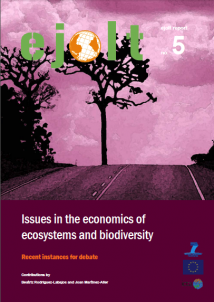
The Nagoya Conference of the Parties of the Convention on Biodiversity in October 2010 had the economics of biodiversity as one of its core topics. Some weeks before the meeting, the economic media insisted on the relevance of biodiversity. As an example, The Economist devoted fourteen pages to the pressures on the world’s forests, mentioning among the responses to save them the information of the TEEB initiative (The Economist , 29/09/2010). The UNEP sponsored The Economics of Ecosystems and Biodiversity (TEEB) reports (Kumar 2010; ten Brink 2011) that were born from an initiative in 2007 to have an economic analysis of biodiversity loss parallel to that of the Stern report on climate change. It was expected that economic valuation would make biodiversity loss more visible socially and politically.
Economic growth and human population growth are forces driving biodiversity loss. Therefore, the idea that economics (which generally preaches economic growth) may provide concepts and instruments for biodiversity conservation is at first sight surprising. We side with the sceptics (McCauley 2006; Kosoy and Corbera 2009; Spangenberg and Settele 2010) but we understand the logic of those who are keen to apply monetary valuation and payment for ecosystem services. In some instances (for example, a court case for damages to the environment and to human health) money valuation is appropriate, as we see in the Chevron and Shell cases in Ecuador and Nigeria (in the third section of this report). However, in a dispute on shrimp farming in Ecuador or on bauxite mining in Orissa (described in the third and fifth sections), should cost-benefit analysis be applied (calculating all positive and negative impacts in monetary terms and choosing the option representing the highest economic value), or should the relevant environmental, social and cultural values have a chance to be deployed in their own units of account as in (some forms of) multi-criteria evaluation? We examine these questions in EJOLT Report 5: Issues in the economics of ecosystems and biodiversity
One early TEEB public meeting took place at the World Conservation Congress in Barcelona in October 2008. An observer wrote that TEEB Advisory Board member Joan Martinez-Alier endorsed an approach of epistemic pluralism. “The ecological economist supported TEEB for tactical reasons but sparked spontaneous applause when he argued for an ‘orchestra of instruments’. Economic valuation is an instrument that some people understand very well, and it is very relevant, but we have a whole orchestra of instruments to talk about different valuations. Territorial rights, aesthetics, ecological sacredness for many people around the world, tribal people, are also very relevant values. There is an incommensurability of values that we have to recognise ” (Monfreda 2010: 284).
After this introduction, the next section analyzes the main driving forces of biodiversity loss and the birth of the economics of conservation as a response to this process. The rest of the report argues, using examples where the authors have been involved to some extent, that economics can be used in different modes, in support to alternative approaches to conservation.
One is the valuation of ecosystem products and services (Fearnside 1997; Costanza et al. 1997). If an area of mangroves or tropical rainforest disappears, how much is lost in money terms from the products and services foregone? The third section analyses efforts to halt or reverse or compensate for biodiversity loss by monetary valuation (TEEB, mangroves, Chevron-Texaco).
Another approach, described in the fourth section, includes proposals to halt biodiversity loss through the protection of ecosystem functions and services, where the assessment not necessarily involves monetary valuation of all costs and benefits. For instance, as explained below, the European Water Directive asks for certain qualities to be maintained or achieved (in terms of physical, chemical and biological attributes of the river), and one can then compute the monetary costs of doing so. This approach is related to that of counting the opportunity costs of the Yasuni ITT initiative in Ecuador also described below.
A third approach encompasses attempts to halt biodiversity loss through the prevalence of non-chrematistic cultural and livelihood values. The fifth section looks at the deployment of plural values, like livelihood, human rights, sacredness and the Rights of Nature in controversies of conservation, using cases from India (the Niyamgiri Hill) and Ecuador (the defence of mangroves by local communities, the enforcement of Rights of Nature). The final section contains the conclusions.


